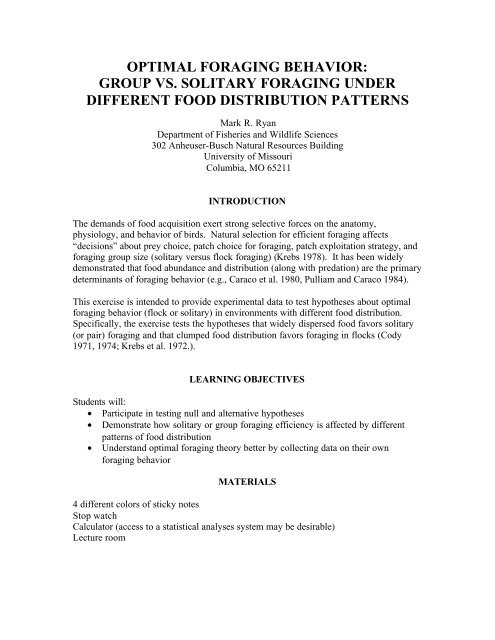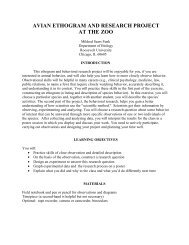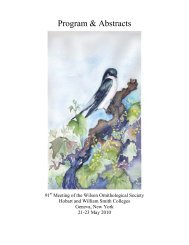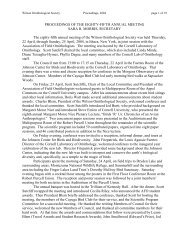OPTIMAL FORAGING BEHAVIOR: GROUP VS. SOLITARY ...
OPTIMAL FORAGING BEHAVIOR: GROUP VS. SOLITARY ...
OPTIMAL FORAGING BEHAVIOR: GROUP VS. SOLITARY ...
You also want an ePaper? Increase the reach of your titles
YUMPU automatically turns print PDFs into web optimized ePapers that Google loves.
<strong>OPTIMAL</strong> <strong>FORAGING</strong> <strong>BEHAVIOR</strong>:<br />
<strong>GROUP</strong> <strong>VS</strong>. <strong>SOLITARY</strong> <strong>FORAGING</strong> UNDER<br />
DIFFERENT FOOD DISTRIBUTION PATTERNS<br />
Mark R. Ryan<br />
Department of Fisheries and Wildlife Sciences<br />
302 Anheuser-Busch Natural Resources Building<br />
University of Missouri<br />
Columbia, MO 65211<br />
INTRODUCTION<br />
The demands of food acquisition exert strong selective forces on the anatomy,<br />
physiology, and behavior of birds. Natural selection for efficient foraging affects<br />
“decisions” about prey choice, patch choice for foraging, patch exploitation strategy, and<br />
foraging group size (solitary versus flock foraging) (Krebs 1978). It has been widely<br />
demonstrated that food abundance and distribution (along with predation) are the primary<br />
determinants of foraging behavior (e.g., Caraco et al. 1980, Pulliam and Caraco 1984).<br />
This exercise is intended to provide experimental data to test hypotheses about optimal<br />
foraging behavior (flock or solitary) in environments with different food distribution.<br />
Specifically, the exercise tests the hypotheses that widely dispersed food favors solitary<br />
(or pair) foraging and that clumped food distribution favors foraging in flocks (Cody<br />
1971, 1974; Krebs et al. 1972.).<br />
LEARNING OBJECTIVES<br />
Students will:<br />
• Participate in testing null and alternative hypotheses<br />
• Demonstrate how solitary or group foraging efficiency is affected by different<br />
patterns of food distribution<br />
• Understand optimal foraging theory better by collecting data on their own<br />
foraging behavior<br />
MATERIALS<br />
4 different colors of sticky notes<br />
Stop watch<br />
Calculator (access to a statistical analyses system may be desirable)<br />
Lecture room
PROCEDURE<br />
Previous studies suggest that when food is approximately evenly dispersed in an<br />
environment, solitary foraging yields a higher energy return per unit time (or less time to<br />
acquire a set amount of energy) (Verbeek 1973). Alternatively, when food is clumped,<br />
flock foraging is more efficient (Zahavi 1971, Krebs et al. 1972). To let students<br />
experience these non-intuitive concepts, this exercise lets students be “foragers”<br />
searching for “prey.” The foraging environment is the classroom, prey are colored note<br />
papers attached to the underside of desks or chairs, and the birds are students. Four basic<br />
trials are conducted in this exercise to test the following hypotheses.<br />
Hypothesis 1. There is no difference in time required to locate and capture<br />
prey necessary to meet energy requirements between solitary and flock<br />
foragers when food is evenly (approximately) distributed in space.<br />
Alternative Hypothesis 1a. Solitary foragers require less time to locate and capture<br />
prey than flock foragers when food is evenly (approximately) distributed in<br />
space.<br />
Hypothesis 2. There is no difference in time to acquire prey needed to meet energy<br />
requirements between group and solitary foragers when food is patchily<br />
distributed (clumped) in space.<br />
Alternative Hypothesis 2a. Group foragers require less time than solitary foragers<br />
to acquire prey to meet needed energy demand when food is patchily<br />
distributed (clumped) in space.<br />
Classrooms of almost any size can be used for this exercise, but very small ones (ca. 20<br />
desks) introduce larger chance variation in the results. I have used the experiment<br />
successfully in banked or flat classrooms with from 60 to >100 desks (or chairs).<br />
Separate trials (with replicates if desired) with solitary and with flock foragers are<br />
conducted to test each hypothesis resulting in 4 different trials.<br />
For Trial 1 (solitary foragers; food evenly dispersed), 12 sticky notes (all of a single<br />
color, e.g., blue) are placed in a widely dispersed (pseudo-uniform) pattern on the<br />
underside of desktops or chairs. Nine student volunteers are gathered outside the<br />
foraging patch (e.g., at the front of the class). Other students act as timekeepers. On a set<br />
signal the student foragers begin searching for food (sticky notes) in the foraging patch<br />
(set of desks). Students are told that once they find and “capture” a food item (i.e., met<br />
their daily energy need) they should leave the foraging patch. Total elapsed time from<br />
beginning of search until a prey item is captured is recorded for each student forager<br />
(alternatively total time elapsed until the last of the 9 foragers captures a food item can be<br />
recorded).<br />
For Trial 2 (group foraging, food evenly dispersed), 12 sticky notes (of a different color,<br />
e.g., yellow) are again distributed in a widely dispersed pattern in the classroom. Again 9
student volunteers are gathered outside the foraging patch. To simulate flock foraging,<br />
students should be grouped into 3 flocks of 3 individuals. Flock integrity is maintained<br />
by requiring students to hold hands through the foraging bout. To mimic within flock<br />
dominance hierarchies and possible interference during prey capture, student flocks<br />
should have a dominance hierarchy assigned (e.g., by student height). Subordinate<br />
individuals must pass any prey item they capture to the next highest ranking individual in<br />
the flock until all (if any) higher ranking individuals have been fed. Once all members of<br />
a flock have obtained 1 prey item the flock should leave the patch. Time from onset of<br />
foraging until each individual within flocks captures a prey item should be recorded.<br />
Again, to simplify, record only total elapsed time from initiation of foraging until the last<br />
individual locates a prey item.<br />
To test hypotheses regarding solitary and flock foraging efficiency when food is clumped<br />
also requires 2 different trials. For Trial 3 (solitary foraging; food clumped) 12 sticky<br />
notes (all of a single color, e.g., green) are placed in a clumped distribution throughout<br />
the classroom foraging environment. Distribute the sticky notes in 4 clusters with 3 prey<br />
items in each cluster (under a single desk or adjoining desks). Nine foragers again search<br />
individually for prey and total elapsed time is recorded for each.<br />
For Trial 4 (flock foraging, food clumped), again distribute sticky notes (e.g., pink) in a<br />
clumped distribution as in trial 3. Nine student foragers should be arranged in flocks and<br />
forage under the rules described for trial 2.<br />
To prevent “information transfer” (sensu Zahavi 1971), all sticky notes should be hidden<br />
prior to students entry into the classroom. Additionally, having different students act as<br />
foragers in each trial reduces errors associated with learning patch characteristics, search<br />
image development, etc. When notes for the 4 trials are all distributed before class time,<br />
care must be taken to prevent mistakes in prey choice (wrong color of sticky notes). I tell<br />
students that prey other than their assigned (preferred) items are unpalatable or toxic and<br />
if they inadvertently capture them (remove them from under the desk) they must be<br />
replaced immediately.<br />
After the trials are completed, means and variances of foraging times for the different<br />
trials can be calculated. If desired the data can be analyzed statistically to test the stated<br />
hypotheses. Alternatively, total elapsed time until the last forager in each trial found a<br />
prey item can be examined to assess the hypotheses and used to discuss the concept of<br />
foraging efficiency and optimality. Discussion of what happened during the foraging<br />
trials usually results in observations of “information transfer,” learning of prey locations,<br />
etc. being raised. In repeated trials at the University of Missouri it has been rare that the<br />
data have not supported the theoretically expected results (the alternative hypotheses). In<br />
any case, discussion of what went wrong can be insightful. Occasionally the last forager<br />
to capture a prey item takes an inordinately long time to find their prey. This can be<br />
discussed in terms of patch depletion and strategies for knowing when to leave a patch in<br />
search of another, higher quality patch. [Note: the reason for the number of prey items<br />
(12) exceeding the number of foragers (9) is too minimize prey depletion effects]
REFERENCES<br />
Caraco, T. 1979. Time budgeting and group size: a test of theory. Ecology 60:618-627.<br />
_____., S. Martindale, and H. R. Pulliam. 1980. Flocking: advantages and<br />
disadvantages. Nature 285:400-401.<br />
Cody, M. L. 1971. Finch flocks in the Mohave Desert. Theor. Pop. Biol. 2:142-148.<br />
_____. 1974. Optimization in ecology. Science 183:1156-1164.<br />
Krebs, J. R., M. H. MacRoberts, and J. M. Cullen. 1972. Flocking and feeding in the<br />
great tit Parus major: an experimental study. Ibis 114:507-530.<br />
Pulliam, H. R., and T. Caraco. 1984. Living in groups: is there an optimal group size?<br />
Pages 122-147 In J. R. Krebs and N. B. Davies, eds. Behavioral Ecology: An<br />
Evolutionary Approach. Second Ed., Blackwell Scientific Publications, Oxford,<br />
England<br />
Verbeek, N. A. M. 1973. The exploitation system of the Yellow-billed Magpie. Univ.<br />
Calif. Publ. Zool. 99:1-58<br />
Zahavi, A. 1971. The social behavior of the White Wagtail Motacilla alba alba<br />
wintering in Israel. Ibis 113:203-211.





